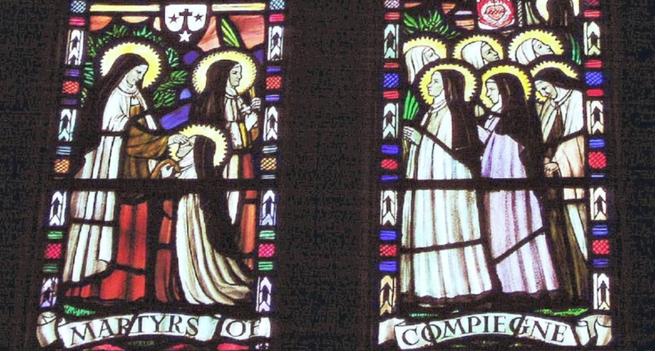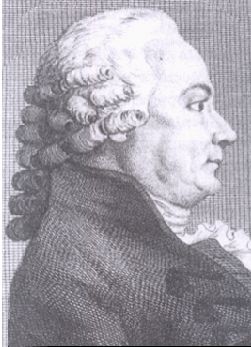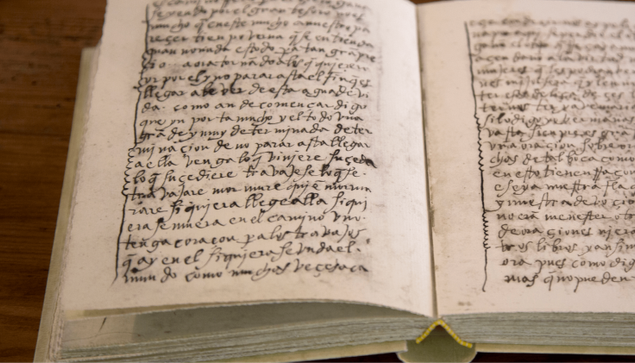Quote of the day, 11 January: Conrad de Meester, O.C.D.
Profession of
St. Elizabeth of the Trinity
Sunday, 11 January 1903
“My Mother, here is the Bridegroom!” (L 155).
After the 8 o’clock Mass, the community, in their white mantles and a large candle in their hands, go up the grand staircase to the chapter room, singing the O gloriosa Virginum (“O glorious Virgin”) to Mary. As a small cell of the Church, the community experiences the profession as a great moment of universal significance, an offering for the universal Church. United in intimacy, it’s also the family that’s going to grow. At the end of the procession, the prioress leads the novice by the hand.
The account of Sister Mary of the Trinity, plainly taken up again in the Memoirs (S 107), introduces us to this supreme act:
“Her profession was still made entirely in faith, but already in peace since her visit with the priest. She tells us that she was taken up by the idea of sacrifice and immolation alone. Especially as she climbed the steps, going up to the chapter room, she was strongly taken, seized by this thought and then told us that she had found her whole state of mind in the day’s reading: ‘Offer your bodies to God as pure, holy and pleasing hosts to God’” (cf. Rom 12:1).
Climbing the stairs reminds Elizabeth of the symbol of the mountain, whether it be Tabor or Calvary—like Abraham going up to the top of the mountain indicated by Yahweh to sacrifice his son Isaac (cf. Gen 22:1-19), like Jesus Christ on his way to the Cross. Each stair-step is a decisive movement towards total self-giving to God, prayer, and sacrifice for the Church.
Detail of the grand, spiral staircase in the ruins of the first Carmelite monastery on Mount Carmel. As a tradition, many monasteries of Carmelite nuns are built to include a monumental, spiral staircase. See the complete photo here.Image credit: biblewalks.com
Upon arriving in the chapter room, the Prioress sits on the left side of the altar. Elizabeth kneels before her. Mother Germaine asks her the same questions as on the day she took the habit. The same answers resound—standard, formulated answers—but with great density, essential expressions of what one is seeking. After Elisabeth has thus sought “the mercy of God, the poverty of the Order and the company of her sisters,” the Prioress reminds her of the demands of the narrow path she is following forever.
Then, with her hands joined in those of the Prioress, Mother Germaine of Jesus, Elizabeth Catez repeated the formula of her profession three times: “I, Sister Mary Elizabeth of the Trinity, make my profession, and I promise chastity, poverty and obedience to God, Our Lord, and to the Blessed Virgin Mary,” in obedience to the superiors “according to the primitive, unmitigated Rule of the Order of Mount Carmel until death.”
Translator’s Note—In English-speaking Discalced Carmelite monasteries, the formula was: I, Sister N. of N., make my solemn profession and I promise obedience, chastity, and poverty to God, to the Most Blessed Virgin Mary of Mount Carmel, and to you, Rev. Mother Prioress, and to your successors, according to the primitive Rule of the Discalced Carmelites and our Constitutions, until death.
In this very sparse setting, the words resonate…
After the prayers offered by the Prioress, as on the day she took the habit, the newly professed is clothed in her Marian scapular and white mantle to symbolize the new life received from the Risen One. Now she lies on the floor in the form of a cross on the wool carpet decorated with flowers while the community sings the Te Deum. After she has been sprinkled with holy water, a reminder of the water of Baptism, Sister Elizabeth of the Trinity rises, kneels before the Prioress, kisses her hand, embraces her, and goes to kiss all the sisters as they sing Psalm 133, Ecce quam bonum: See how good it will be to live together as true sisters.
On Sunday, 11 January 1903 it was freezing in Dijon. The temperature was -5 (23 F) and a snowstorm would arrive the next day in eastern France. This photo, however, was taken by Sister Geneviève some days after Elizabeth received the black veil on 21 January 1903. The remaining snow from earlier in the month appears in the garden.Image credit: Discalced Carmelites
Detailed view of Elizabeth’s profession crucifix. See the complete image here. She receives her profession crucifix, on the back of which she has had St. Paul’s words engraved in Latin: “It is no longer I who live, but it is Christ who lives in me” (Gal 2:20). She also receives her copy of the Constitutions of the Order and the Prioress places a crown of flowers on her head, which she wears all day long, she who is Christ’s bride.
During the day’s prayers, she is the one who presides. At meals and evening recreation, she sits between the Prioress and the Sub-Prioress, her place in the refectory being adorned with flowers. The community has “license” today to visit each other, but the newly professed remains in silence, in a prayer of gratitude and love, until the joyful and emotional gathering during the evening recreation.
After Compline, the Prioress removes the crown from Elizabeth who will place it in front of the statue of Our Lady of Grace in the cloister, the Queen of Heaven, of whom she wants to remain more than ever the daughter, the mystical Spouse of Jesus.
Conrad de Meester, O.C.D.
Rien Moins Que Dieu: Sainte Elisabeth de la Trinité
Chap. 22: Chaque jour ma vie d’épouse (excerpt)
Note: We invite our readers to explore the official website of St. Elizabeth of the Trinity. Although the website has not yet been completely translated to in English, the most important information has been translated for English visitors.
https://youtu.be/XHFggZzlUGw
Elizabeth of the Trinity, S 1984, Je te cherche dès l’aurore : évocation d’un visage et d’un coeur, produced by C. de Meester and the Carmel of Dijon, Carmel de Dijon, Flavignerot.
Elizabeth of the Trinity, S, de Meester, C, Lonchampt, J, 1980, Oeuvres Complètes, Les Editions du Cerf, Paris.
Elizabeth of the Trinity, S 2003, The Complete Works of Elizabeth of the Trinity volume 2: Letters from Carmel, translated from the French by Nash, A, ICS Publications, Washington DC.
Translation from the French text is the blogger’s own work product and may not be reproduced without permission.
Featured image: Profession photo 63 from the photo album Je te cherche dès l’aurore published by the Carmel of Dijon. Image credit: Discalced Carmelites
#biography #ConradDeMeester #GregorianChant #history #religiousProfession #spirituality #StElizabethOfTheTrinity





